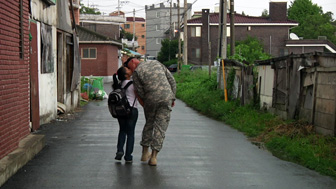The Woman, the Orphan, and the Tiger
 KOREA, DENMARK, USA, CHINA / 2010 / English, Danish, Korean / Color, B&W / Blu-ray (HD) / 76 min
KOREA, DENMARK, USA, CHINA / 2010 / English, Danish, Korean / Color, B&W / Blu-ray (HD) / 76 min
Directors, Photography, Editing, Producers: Jane Jin Kaisen, Guston Sondin-Kung
Sound: Shim Hyun-Jung, Jane Jin Kaisen, Guston Sondin-Kung
Source: itinerant_sends_for_itinerant
www.itinerantsendsforitinerant.org
A contemplative approach to reconstructing Korean history from the era of Japanese colonial rule to the current day under U.S. hegemony, mainly with archival footage and opinions from the female Korean diaspora; former “comfort women” of the Japanese military, female sex workers for the American soldiers stationed in Korea, and the many children adopted by Americans and Europeans since the Korean War. By connecting the dots of the women’s lives, through the individual voices and histories that have been trapped, the film shows how Woman has been subjected to continual violence.
[Director’s Statement] In The Woman, the Orphan, and the Tiger, a genealogy is created by relating the stories of three generations of women: first, the approximately 200,000 former comfort women from various countries in Asia who were subjected to military sexual slavery by the Japanese military between World Wars I and II; second, the approximately one million women who have worked as sex workers around U.S. military bases in South Korea since the 1950s; and third, the approximately 200,000 children who were adopted from South Korea to the West from the 1950s to the present.
Instead of trying to create a genealogy based on national identification or biological or ethnic ties, the genealogy constructed in the film is a strategic and political one. It looks at the ways in which several generations of women were affected by similar oppressive regimes, while accounting for the multiple subjectivities and different issues at stake. The film explores how bio-political violence against women’s and children’s bodies was mobilized for national security and economic growth and became central in geopolitical negotiations among South Korea, the United States, and Japan. This part of world history has been systematically silenced, but, largely due to efforts of the “diaspora,” it is beginning to surface and counter dominant narratives in South Korea and in the West.
The Woman, the Orphan, and the Tiger is a film about trying to remember something which one might not even know about, or speak something which has been methodologically repressed but which is embodied in the present, where it manifests as residues and effects of collective trauma. In order to account for these gaps in narratives and the emotional effects of trauma and social stigmatization, various non-linear and experimental modes of storytelling are applied in the film.
 (From the left)
(From the left)Jane Jin Kaisen, Guston Sondin-Kung Jane Jin Kaisen and Guston Sondin-Kung have been working for the last three years collaboratively as visual artists and filmmakers. They locate their practice within the discourse surrounding emerging contested histories, places where historical truth is actively disputed and its effects felt through traumatic dislocation. This allows their actions to directly influence the (as yet to be defined) discourse. They take the totality of these contested histories looking to a large body of traces surrounding the events, places, people, and collective psychology. They see this total situation as an event that requires a complex set of language(s) to describe. Due to this, the outcome is typically a proposition that contains statements. They have screened and exhibited their work at Videonale 13 Kunstmuseum Bonn, the Taiwan International Documentary Festival, Kunsthallen Nikolaj, Scandinavia House New York, Vox Populi Gallery, and The Open International Performance Art Festival, among others. |
